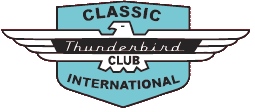Hall of Fame
Recognition may be given for elevation to the CTCI Hall of Fame to an individual who, in the opinion of the CTCI Board of Directors, has contributed to the design, development, or promotion of the two-passenger Ford Thunderbird Automobiles.
The individuals who are in the Thunderbird Hall of Fame are as follows:
Bill Elliott
July 26, 1994
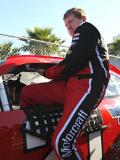 With the introduction of the new “aero” look for the Thunderbirds in 1983 they became more attractive as race cars. In 1985 famed race car driver, Bill Elliott punctuated Thunderbird’s racing history by capturing 11 superspeedway races, becoming the only NASCAR driver to have ever won the Winston Million, and by taking three of NASCAR’s four biggest races in a single year. Elliott has won an incredible 39 races during his career.
With the introduction of the new “aero” look for the Thunderbirds in 1983 they became more attractive as race cars. In 1985 famed race car driver, Bill Elliott punctuated Thunderbird’s racing history by capturing 11 superspeedway races, becoming the only NASCAR driver to have ever won the Winston Million, and by taking three of NASCAR’s four biggest races in a single year. Elliott has won an incredible 39 races during his career.
See page 19 in the Sept/Oct 1994 Early Bird for the complete story.
Photo credit: Getty Images
William P. Boyer, Jr.
July 26, 1994
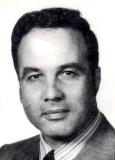 Bill Boyer was hired from GM by Frank Hershey to work on the then secret Ford Sports Car project. Hershey closely supervised Boyer, along with other designers, in laying down the lines of the car and building the clay model. Bill Boyer’s original design in 1954 singlehandedly erected the personal luxury-car segment in the United States. Public orders totaled more than 3,500 within the first 10 days. While planned volume for the model year was only 10,000 units Ford went on to produce over 16,000 units for that model year.
Bill Boyer was hired from GM by Frank Hershey to work on the then secret Ford Sports Car project. Hershey closely supervised Boyer, along with other designers, in laying down the lines of the car and building the clay model. Bill Boyer’s original design in 1954 singlehandedly erected the personal luxury-car segment in the United States. Public orders totaled more than 3,500 within the first 10 days. While planned volume for the model year was only 10,000 units Ford went on to produce over 16,000 units for that model year.
See page 19 in the Sept/Oct 1994 Early Bird for the complete story.
Jack Telnack
July 26, 1994
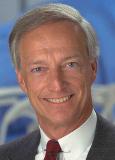
In the early 1980’s Ford Design Vice President Jack Telnack’s decision to shun conventional design ideas resulted in the introduction of Thunderbird’s “aero” styling which has reshaped design conventions in the entire automotive industry, winning Motor Trend’s “car of the Year” awards in 1987 and 1989. This “aero” styling has lasted well into the 21st Century and was truly a milestone step in automotive design pioneered by the Thunderbird.
See page 19 in the Sept/Oct 1994 Early Bird for the complete story.
Alden Giberson
July 26, 1994
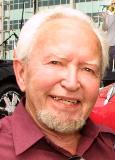 As a young Ford car stylist, Alden “Gib” Giberson (pronounced GUY-ber-son) was the one who suggested the name “Thunderbird”. “Gib” lived and worked for a time in the Southwest and was familiar with Southwest Indian culture and lore. Ford management endlessly considered all the suggested names and finally, just prior to the car’s unveiling at a Press Preview, held on February 17, 1954, top management selected “Thunderbird” from the many suggestions made by the stylists.
As a young Ford car stylist, Alden “Gib” Giberson (pronounced GUY-ber-son) was the one who suggested the name “Thunderbird”. “Gib” lived and worked for a time in the Southwest and was familiar with Southwest Indian culture and lore. Ford management endlessly considered all the suggested names and finally, just prior to the car’s unveiling at a Press Preview, held on February 17, 1954, top management selected “Thunderbird” from the many suggestions made by the stylists.
See page 19 in the Sept/Oct 1994 Early Bird for the complete story.
Franklin Q. Hershey
January 26, 2006
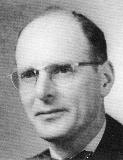 Franklin Q. Hershey was a legendary designer when he joined Ford in early 1952. Having cut his styling teeth at Walter Murphy Body Co. of Los Angeles in the late ’20s and early ’30s, he went on to work at Hudson, and then to GM (Pontiac) prior to World War II. At GM he spent a few years working at their Opel plant in Germany, just prior to the outbreak of the war. In 1944, he was appointed head of the Cadillac styling studio. In the late ’40s Frank worked for Packard before being hired as Chief Stylist of the Ford Division.
Franklin Q. Hershey was a legendary designer when he joined Ford in early 1952. Having cut his styling teeth at Walter Murphy Body Co. of Los Angeles in the late ’20s and early ’30s, he went on to work at Hudson, and then to GM (Pontiac) prior to World War II. At GM he spent a few years working at their Opel plant in Germany, just prior to the outbreak of the war. In 1944, he was appointed head of the Cadillac styling studio. In the late ’40s Frank worked for Packard before being hired as Chief Stylist of the Ford Division.
See page 16 in the March/April 2006 Early Bird for the complete story.
Photo reprinted from: Ford Design Department Concept and Show Cars 1932-1961 by: Jim and Cheryl Farrell.
Thomas B. Case
January 26, 2006
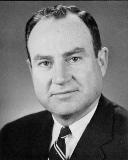 Thomas B. Case was assigned to the Ford Sports Car project once it got the official “go ahead” from top management. In his great book,Thunderbird; An Odyssey in Automotive Design, Bill Boyer stated Tom’s job was to monitor the development of the car from the styling, engineering, and mock-up phases, and then ready the design for production. In carrying out his duties, Case was responsible for issuing product letters that dictated how parts would appear based on decisions made by executives.
Thomas B. Case was assigned to the Ford Sports Car project once it got the official “go ahead” from top management. In his great book,Thunderbird; An Odyssey in Automotive Design, Bill Boyer stated Tom’s job was to monitor the development of the car from the styling, engineering, and mock-up phases, and then ready the design for production. In carrying out his duties, Case was responsible for issuing product letters that dictated how parts would appear based on decisions made by executives.
See page 16 in the March/April 2006 Early Bird for the complete story.
Allan E. Kornmiller
July 3, 2006
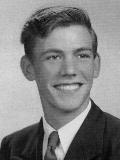 Allan was employed by Ford in 1951 and assigned to work in the Advanced Styling Studio. In early 1952, he, along with Bill Boyer and John Samsen, were asked by Ford Chief Stylist Franklin Hershey to prepare full size artistic renderings of what they believed a sports car should look like. Each designer was provided with size specifications such as wheel base, height, and length which were dictated by the Engineering Department. Shortly thereafter, theme proposals were shown to senior management who liked certain aspects of all three designs.
Allan was employed by Ford in 1951 and assigned to work in the Advanced Styling Studio. In early 1952, he, along with Bill Boyer and John Samsen, were asked by Ford Chief Stylist Franklin Hershey to prepare full size artistic renderings of what they believed a sports car should look like. Each designer was provided with size specifications such as wheel base, height, and length which were dictated by the Engineering Department. Shortly thereafter, theme proposals were shown to senior management who liked certain aspects of all three designs.
See page 10 in the Nov/Dec 2006 Early Bird for the complete story.
John R. Samsen
July 3, 2006
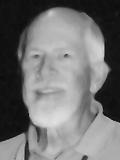 John was employed by Ford in March 1952 and was assigned by Ford Chief Stylist Franklin Hershey to work in the Body Development Studio. While assigned to this studio, John produced artistic renderings of various side views of the 1955 Ford passenger car which was in final stages of design, along with various versions of the tail light and side ornamentation. Along with Bill Boyer and Allan Kornmiller, he was asked by Frank Hershey to prepare full size artistic renderings of what they believed a sports car should look like based on size specifications which were dictated by the Engineering Department.
John was employed by Ford in March 1952 and was assigned by Ford Chief Stylist Franklin Hershey to work in the Body Development Studio. While assigned to this studio, John produced artistic renderings of various side views of the 1955 Ford passenger car which was in final stages of design, along with various versions of the tail light and side ornamentation. Along with Bill Boyer and Allan Kornmiller, he was asked by Frank Hershey to prepare full size artistic renderings of what they believed a sports car should look like based on size specifications which were dictated by the Engineering Department.
See page 8 in the Nov/Dec 2006 Early Bird for the complete story.
Lois Eminger
February 7, 2009
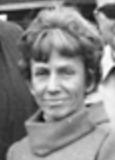 Perhaps one of Lois’ most valuable contributions to owners of the two-passenger Thunderbirds was her intervention with Ford’s decision to discard dated Factory Invoices. Lois was able to obtain the massive files for all but the early production ’55 T-Birds. Lois was also instrumental in convincing Ford to produce a run of desperately needed T-Bird sheet metal. After a decade of tireless negotiation, Ford resurrected the original dies and authorized the Budd Co. to produce a (limited) run of sheet metal parts in 1972/73. Lois was the ideal ambassador for CTCI’s long-time alliance with Ford.
Perhaps one of Lois’ most valuable contributions to owners of the two-passenger Thunderbirds was her intervention with Ford’s decision to discard dated Factory Invoices. Lois was able to obtain the massive files for all but the early production ’55 T-Birds. Lois was also instrumental in convincing Ford to produce a run of desperately needed T-Bird sheet metal. After a decade of tireless negotiation, Ford resurrected the original dies and authorized the Budd Co. to produce a (limited) run of sheet metal parts in 1972/73. Lois was the ideal ambassador for CTCI’s long-time alliance with Ford.
See page 7 in the May/June 2009 Early Bird for the complete story.
Chase Morsey, Jr.
July 31, 2013
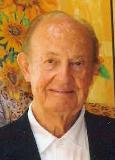 Chase Morsey, Jr. served as the Chief Product Planner of the Ford Division of the Ford Motor Company during the early 1950’s. This was the same time period the 1955 Thunderbird entered its engineering and design phase. He is credited with recruiting the Budd Company to build the bodies, settled several management disputes over the car’s design, adapted the 1956 Continental Mark II roofline to the hard top, ensured that several power and creature comfort options would be available to buyers, and coined the marketing term, “personal car”, given to the Thunderbird by Ford.
Chase Morsey, Jr. served as the Chief Product Planner of the Ford Division of the Ford Motor Company during the early 1950’s. This was the same time period the 1955 Thunderbird entered its engineering and design phase. He is credited with recruiting the Budd Company to build the bodies, settled several management disputes over the car’s design, adapted the 1956 Continental Mark II roofline to the hard top, ensured that several power and creature comfort options would be available to buyers, and coined the marketing term, “personal car”, given to the Thunderbird by Ford.
See page 9 in the Sept/Oct 2013 Early Bird for the complete story.
Vic Take and Roger & Edna Neiss
February 7, 2014
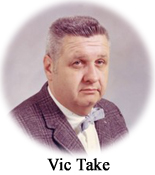
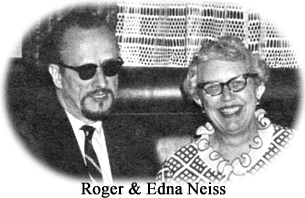 Way back in 1961, Vic Take got the idea for starting a club for the 1955-1957 Thunderbirds. He began a newsletter and charged $1 a year. Things boomed, but after a couple of years, Vic found himself overwhelmed trying to keep up with it all from his home in the St. Louis area.
Way back in 1961, Vic Take got the idea for starting a club for the 1955-1957 Thunderbirds. He began a newsletter and charged $1 a year. Things boomed, but after a couple of years, Vic found himself overwhelmed trying to keep up with it all from his home in the St. Louis area.
Vic approached the BATOC club to take over the fledgling CTCI. Roger Neiss volunteered for the task, with the help of his wife, Edna (Roger and Edna were leaders of BATOC at that time). Roger was associated with the printing business and he started the EarlyBird (Volume 1, Numbers 1&2, Jan/Feb 1963). Roger and Edna continued in this role until late 1971, working out of their home in San Francisco. Due to their efforts, CTCI had really grown in that first decade.
If Vic Take hadn’t had the idea for a Thunderbird club 53 years ago, there might not be a CTCI today. And if Roger and Edna Neiss had not stepped in to take over from Vic, the new T-bird club might have just withered on the vine. It is through the pathfinding efforts of these three people many years ago that sowed the seeds for the Classic Thunderbird Club International that we know today.
See page 11 in the Sept/Oct 2014 Early Bird for the complete story.
Mr. Donnell E. (Sully) Sullivan
March 11, 2022
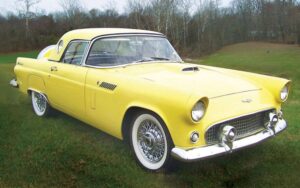 Mr. Donnell E. (Sully) Sullivan made significant engineering contributions while he was employed in Ford’s Engine Engineering Department, later known as the Ford Engine and Driveline Department. During his magnificent 57 year career at Ford, he was closely involved in building race car engines particularly during the 1950s and 1960s. The 292 and 312 cubic inch engines were included in this group of high performance automotive power plants.
Mr. Donnell E. (Sully) Sullivan made significant engineering contributions while he was employed in Ford’s Engine Engineering Department, later known as the Ford Engine and Driveline Department. During his magnificent 57 year career at Ford, he was closely involved in building race car engines particularly during the 1950s and 1960s. The 292 and 312 cubic inch engines were included in this group of high performance automotive power plants.
Sully was heavily involved in the design and engineering of the 312 Cubic Inch High Power Engine Kit which featured an aluminum dual intake manifold, special heads, and two four barrel carburetors. Much of Sully’s work on this project was performed in conjunction with Dearborn Steel Tubing, a Ford Motor Company contractor. The over-the-counter kit was sourced through Ford Dealers and was available to Y-block owners of cars equipped with a manual transmission.
Ford later decided to formally include the dual four barrel engine option for the 1957 model year. Dubbed the “E” engine code, this was an extension of the 1956 High Power Engine Kit program. Sully was very involved in the changes that were made to the dual four barrel carburetor program. A few thousand of these 275 horse power engines found their way into 1957 passenger cars and Thunderbirds. Ford also offered an optional 285 horse power racing version of the dual four barrel Y block.
In the fall of 1956, work began in earnest on the design and development of a supercharged engine that could compete with Chevrolet’s 283 cubic inch fuel injected engine. Sully Sullivan was chosen to be a key member of what became known as the 1957 Ford Supercharger Program. The design team was eventually able to squeeze 300+ horsepower out of a standard 312 cubic inch engine. In February 1957, one hundred factory supercharged cars, 15 of them Thunderbirds, would be produced. It is noted that some of these cars competed at the 1957 Daytona Beach Speed and Time Trials where they met with great success. Sully was also involved in changes to the supercharger program which evolved into the “F” engine code.
According to the Michigan Motor Sports Hall of Fame website, race car fabricator Bill Stroppe was quoted as saying, “If there ever was a Gold Medal given out for racing, Sully should be the one that gets it.”
It is noted that in the summer of 1956, Sully took delivery of a fully optioned 1956 Golden Glow Yellow Thunderbird!
See page 29 in the Nov/Dec 2022 Early Bird for reference.
Gil Baumgartner
2023 – The Award presented to Gil Baumgartner and accepted by the Baumgartner Family
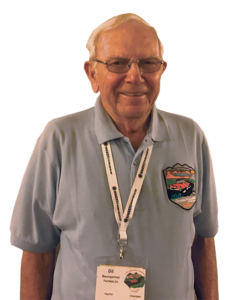 His contribution to CTCI has been extra-extraordinary and hugely impactful. His legacy will carry on in this International Club for as long as there are enthusiasts’ enjoying, restoring and preserving ’55-’57 Thunderbirds.
His contribution to CTCI has been extra-extraordinary and hugely impactful. His legacy will carry on in this International Club for as long as there are enthusiasts’ enjoying, restoring and preserving ’55-’57 Thunderbirds.
A long-time member in good standing in CTCI, since 1971 with member #3557, he has been an asset to CTCI and a mentor and a counselor to many of us over the years. For example:
He created the reference bible for those of us wanting to and actually restoring our Thunderbirds with the creation of The Restoration Manual benefiting restorers world-wide.
For many years, he served as one of our most respected Authenticity Co-Chairman. This role is only assigned to the very best expert in determining which Thunderbird at a Concours judged event merits the highest and most prestigious awards like Gold Medallion, Gold Medallion Preservation, and Excellence in Authenticity awards and whether or not a Thunderbird is truly an Original un-restored car. His word and blessing is the last word without question.
He has been a consistent contributor of technical articles to our bi-monthly Early Bird Magazine making it a highly sought after publication for our world-wide membership.
His contributions to the bi-monthly publication are legendary but so are his technical articles published on or website ranging from body/suspension, steering , electrical, engine, fuel system ignition, transmission to name just a few.
His reputation earned him a guest spot on the syndicated television show, Wheeler Dealers where he demonstrated how to install power windows on a ’57 Thunderbird to the show host and millions of others across the country.
Represented CTCI Region 3 as Director from 1978 through 1981 and then again as Director at Large, 1987 through 1989.
As an Invoice Committee Member he has been responsible for providing the very valuable and authentic invoices to requesting Thunderbird owners. Members on the committee are the only ones with access to the invoice files for the 1955 models after serial number 232214 and substantially all of the 1956 and 1957 models. The significance of his and the committee’s efforts is that for CTCI members having an Invoice gives all a sense of completeness and provides the information that legitimizes our cars. With it we can say with certainty that this is the way our Thunderbirds came from the factory.
